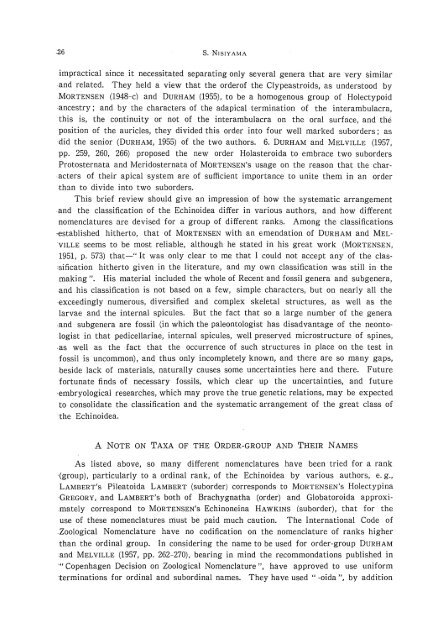the echinoid fauna from japan and adjacent regions part i
the echinoid fauna from japan and adjacent regions part i
the echinoid fauna from japan and adjacent regions part i
You also want an ePaper? Increase the reach of your titles
YUMPU automatically turns print PDFs into web optimized ePapers that Google loves.
.26 S. NISIYAMA<br />
impractical since it necessitated separating only several genera that are very similar<br />
<strong>and</strong> related. They held a view that <strong>the</strong> orderof <strong>the</strong> Clypeastroids, as understood by<br />
MORTENSEN (1948-cl <strong>and</strong> DURHAM (1955), to be a homogenous group of Holectypoid<br />
ancestry; <strong>and</strong> by <strong>the</strong> characters of <strong>the</strong> adapical termination of <strong>the</strong> interambulacra,<br />
this is, <strong>the</strong> continuity or not of <strong>the</strong> interambulacra on <strong>the</strong> oral surface, <strong>and</strong> <strong>the</strong><br />
position of <strong>the</strong> auricles, <strong>the</strong>y divided this order into four well marked suborders; as<br />
did <strong>the</strong> senior (DURHAM, 1955) of <strong>the</strong> two authors. 6. DURHAM <strong>and</strong> MELVILLE (1957,<br />
pp. 259, 260, 266) proposed <strong>the</strong> new order Holasteroida to embrace two suborders<br />
Protosternata <strong>and</strong> Meridosternata of MORTENSEN'S usage on <strong>the</strong> reason that <strong>the</strong> char<br />
·acters of <strong>the</strong>ir apical system are of sufficient importance to unite <strong>the</strong>m in an order<br />
than to divide into two suborders.<br />
This brief review should give an impression of how <strong>the</strong> systematic arrangement<br />
<strong>and</strong> <strong>the</strong> classification of <strong>the</strong> Echinoidea differ in various authors, <strong>and</strong> how different<br />
nomenclatures are devised for a group of different ranks. Among <strong>the</strong> classifications<br />
-established hi<strong>the</strong>rto, that of MORTENSEN with an emendation of DURHAM <strong>and</strong> MEL<br />
VILLE seems to be most reliable, although he stated in his great work (MORTENSEN,<br />
1951, p. 573) that-" It was only clear to me that I could not accept any of <strong>the</strong> clas<br />
:sification hi<strong>the</strong>rto given in <strong>the</strong> literature, <strong>and</strong> my own classification was still in <strong>the</strong><br />
making". His material included <strong>the</strong> whole of Recent <strong>and</strong> fossil genera <strong>and</strong> subgenera,<br />
<strong>and</strong> his classification is not based on a few, simple characters, but on nearly all <strong>the</strong><br />
·exceedingly numerous, diversified <strong>and</strong> complex skeletal structures, as well as <strong>the</strong><br />
larvae <strong>and</strong> <strong>the</strong> internal spicules. But <strong>the</strong> fact that so a large number of <strong>the</strong> genera<br />
<strong>and</strong> subgenera are fossil (in which <strong>the</strong> paleontologist has disadvantage of <strong>the</strong> neontologist<br />
in that pedicellariae, internal spicules, well preserved microstructure of spines,<br />
·as well as <strong>the</strong> fact that <strong>the</strong> occurrence of such structures in place on <strong>the</strong> test in<br />
fossil is uncommon), <strong>and</strong> thus only incompletely known, <strong>and</strong> <strong>the</strong>re are so many gaps,<br />
.beside lack of materials, naturally causes some uncertainties here <strong>and</strong> <strong>the</strong>re. Future<br />
fortunate finds of necessary fossils, which clear up <strong>the</strong> uncertainties, <strong>and</strong> future<br />
embryological researches, which may prove <strong>the</strong> true genetic relations, may be expected<br />
to consolidate <strong>the</strong> classification <strong>and</strong> <strong>the</strong> systematic arrangement of <strong>the</strong> great class of<br />
<strong>the</strong> Echinoidea.<br />
A NOTE ON TAXA OF THE ORDER-GROUP AND THEIR NAMES<br />
As listed above, so many different nomenclatures have been tried for a rank<br />
(group), <strong>part</strong>icularly to a ordinal rank, of <strong>the</strong> Echinoidea by various authors, e. g.,<br />
LAMBERT'S Pileatoida LAMBERT (suborder) corresponds to MORTENSEN'S Holectypina<br />
GREGORY, <strong>and</strong> LAMBERT'S both of Brachygnatha (order) <strong>and</strong> Globatoroida approximately<br />
correspond to MORTENSEN'S Echinoneina HAWKINS (suborder), that for <strong>the</strong><br />
use of <strong>the</strong>se nomenclatures must be paid much caution. The International Code of<br />
.Zoological Nomenclature have no codification on <strong>the</strong> nomenclature of ranks higher<br />
than <strong>the</strong> ordinal group. In considering <strong>the</strong> name to be used for order-group DURHAM<br />
<strong>and</strong> MELVILLE (1957, pp. 262-270), bearing in mind <strong>the</strong> recommondations published in<br />
"Copenhagen Decision on Zoological Nomenclature", have approved to use uniform<br />
·terminations for ordinal <strong>and</strong> subordinal names. They have used" -oida". by addition












